ACCT20075 - Auditing and Ethical Practices Report: CQUniversity
VerifiedAdded on 2023/06/07
|15
|3178
|362
Report
AI Summary
This report provides an analysis of auditing and ethical practices, focusing on the concept of materiality and its computation, along with an examination of audit materiality in the context of inventories, cash, and receivables. It includes a quantitative estimate of materiality for a chosen company (ANN) and discusses disclosures and notes of draft financial statements. The report further analyzes key profit and loss and balance sheet ratios, including profitability, stability, liquidity, and efficiency ratios, with an assessment of potential assertions and audit procedures. It also examines the cash flow statement and going concern risk, concluding with a brief overview of the audit report. Desklib offers similar solved assignments and past papers for students.
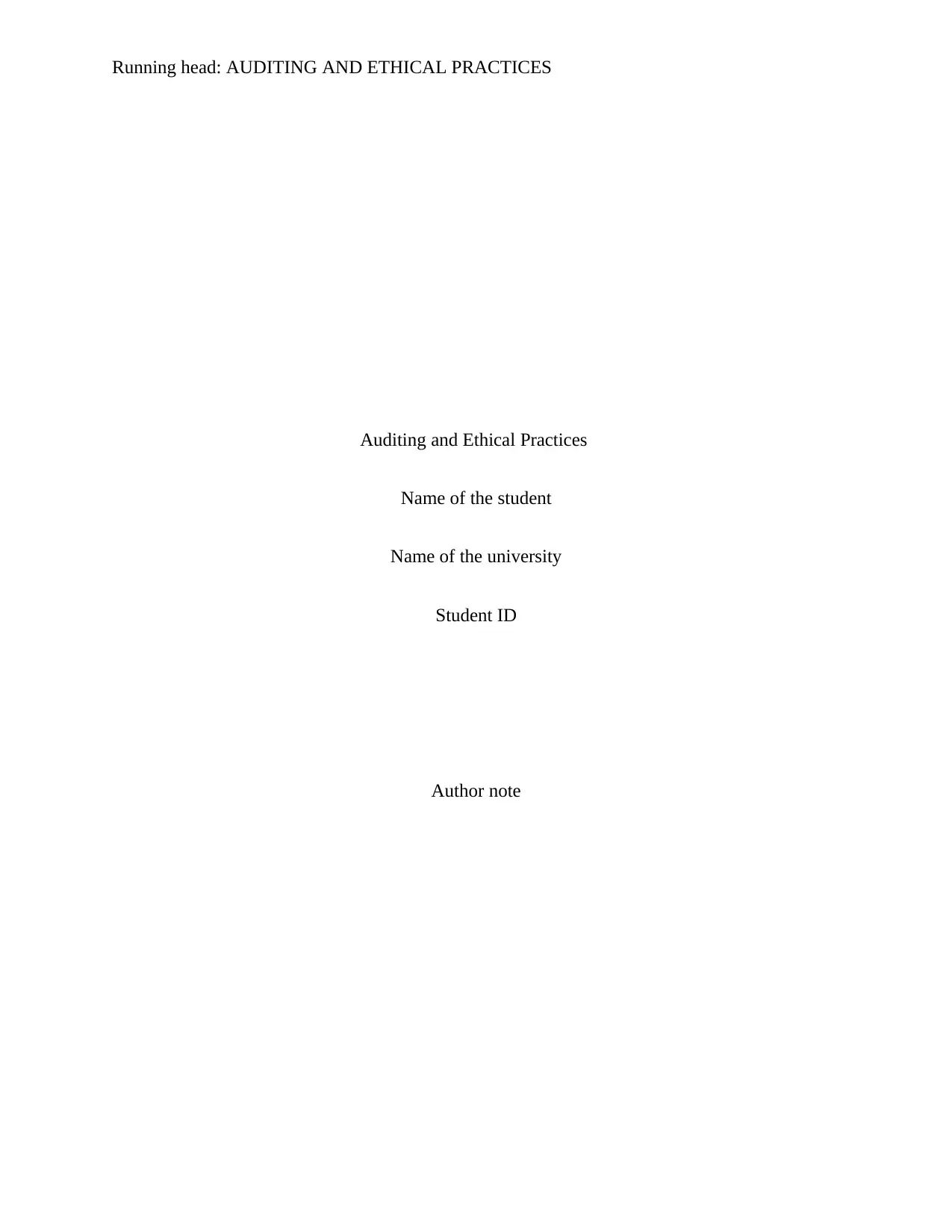
Running head: AUDITING AND ETHICAL PRACTICES
Auditing and Ethical Practices
Name of the student
Name of the university
Student ID
Author note
Auditing and Ethical Practices
Name of the student
Name of the university
Student ID
Author note
Paraphrase This Document
Need a fresh take? Get an instant paraphrase of this document with our AI Paraphraser
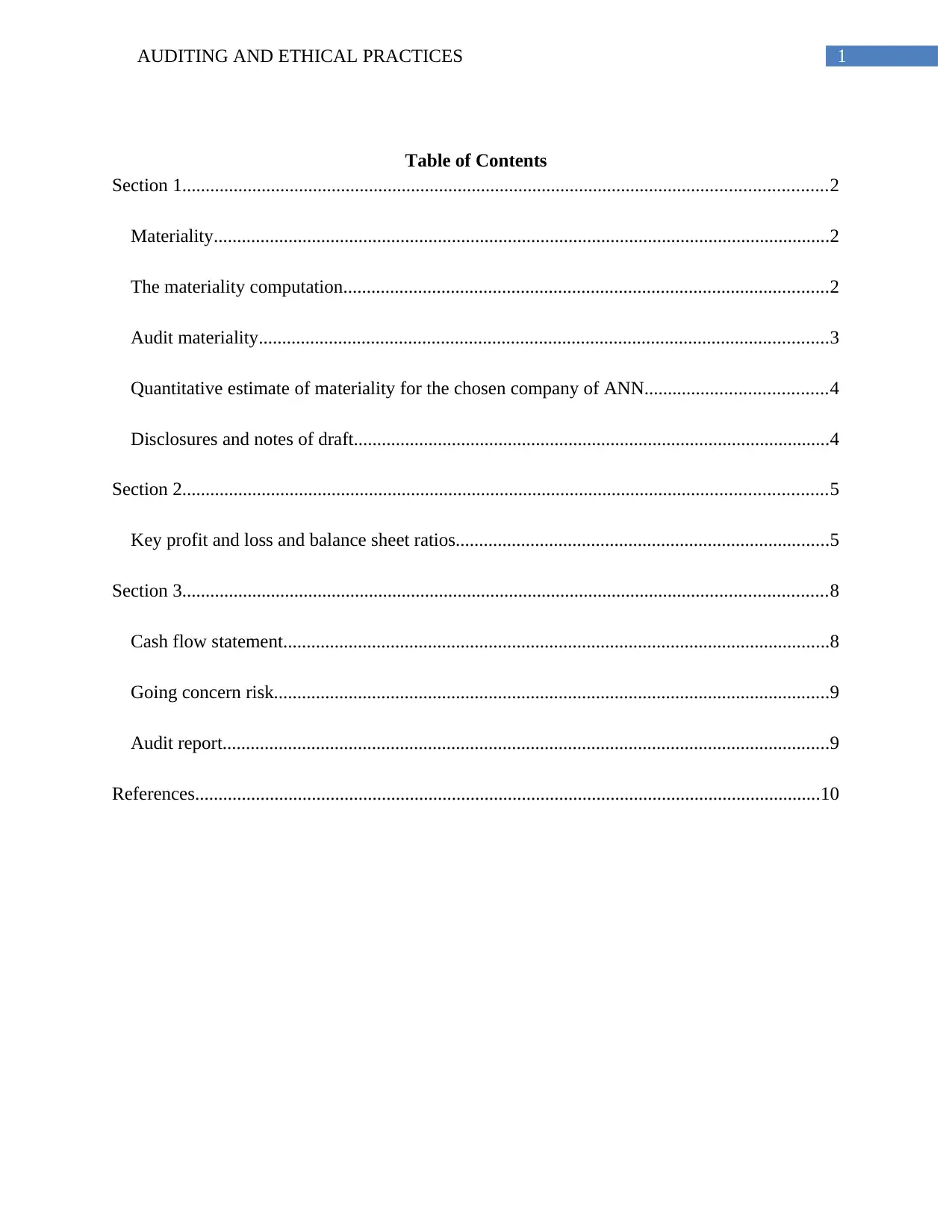
1AUDITING AND ETHICAL PRACTICES
Table of Contents
Section 1..........................................................................................................................................2
Materiality....................................................................................................................................2
The materiality computation........................................................................................................2
Audit materiality..........................................................................................................................3
Quantitative estimate of materiality for the chosen company of ANN.......................................4
Disclosures and notes of draft......................................................................................................4
Section 2..........................................................................................................................................5
Key profit and loss and balance sheet ratios................................................................................5
Section 3..........................................................................................................................................8
Cash flow statement.....................................................................................................................8
Going concern risk.......................................................................................................................9
Audit report..................................................................................................................................9
References......................................................................................................................................10
Table of Contents
Section 1..........................................................................................................................................2
Materiality....................................................................................................................................2
The materiality computation........................................................................................................2
Audit materiality..........................................................................................................................3
Quantitative estimate of materiality for the chosen company of ANN.......................................4
Disclosures and notes of draft......................................................................................................4
Section 2..........................................................................................................................................5
Key profit and loss and balance sheet ratios................................................................................5
Section 3..........................................................................................................................................8
Cash flow statement.....................................................................................................................8
Going concern risk.......................................................................................................................9
Audit report..................................................................................................................................9
References......................................................................................................................................10
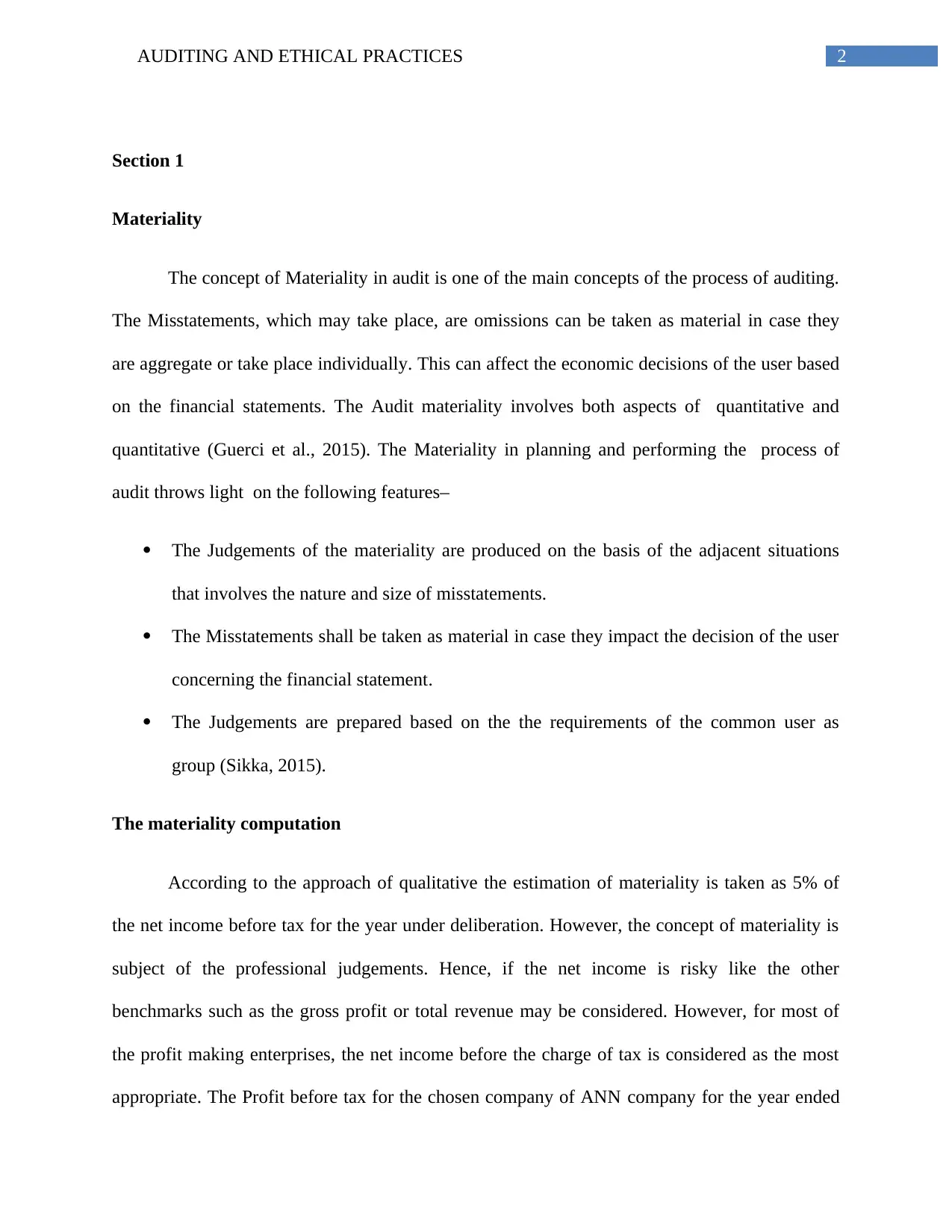
2AUDITING AND ETHICAL PRACTICES
Section 1
Materiality
The concept of Materiality in audit is one of the main concepts of the process of auditing.
The Misstatements, which may take place, are omissions can be taken as material in case they
are aggregate or take place individually. This can affect the economic decisions of the user based
on the financial statements. The Audit materiality involves both aspects of quantitative and
quantitative (Guerci et al., 2015). The Materiality in planning and performing the process of
audit throws light on the following features–
The Judgements of the materiality are produced on the basis of the adjacent situations
that involves the nature and size of misstatements.
The Misstatements shall be taken as material in case they impact the decision of the user
concerning the financial statement.
The Judgements are prepared based on the the requirements of the common user as
group (Sikka, 2015).
The materiality computation
According to the approach of qualitative the estimation of materiality is taken as 5% of
the net income before tax for the year under deliberation. However, the concept of materiality is
subject of the professional judgements. Hence, if the net income is risky like the other
benchmarks such as the gross profit or total revenue may be considered. However, for most of
the profit making enterprises, the net income before the charge of tax is considered as the most
appropriate. The Profit before tax for the chosen company of ANN company for the year ended
Section 1
Materiality
The concept of Materiality in audit is one of the main concepts of the process of auditing.
The Misstatements, which may take place, are omissions can be taken as material in case they
are aggregate or take place individually. This can affect the economic decisions of the user based
on the financial statements. The Audit materiality involves both aspects of quantitative and
quantitative (Guerci et al., 2015). The Materiality in planning and performing the process of
audit throws light on the following features–
The Judgements of the materiality are produced on the basis of the adjacent situations
that involves the nature and size of misstatements.
The Misstatements shall be taken as material in case they impact the decision of the user
concerning the financial statement.
The Judgements are prepared based on the the requirements of the common user as
group (Sikka, 2015).
The materiality computation
According to the approach of qualitative the estimation of materiality is taken as 5% of
the net income before tax for the year under deliberation. However, the concept of materiality is
subject of the professional judgements. Hence, if the net income is risky like the other
benchmarks such as the gross profit or total revenue may be considered. However, for most of
the profit making enterprises, the net income before the charge of tax is considered as the most
appropriate. The Profit before tax for the chosen company of ANN company for the year ended
⊘ This is a preview!⊘
Do you want full access?
Subscribe today to unlock all pages.

Trusted by 1+ million students worldwide
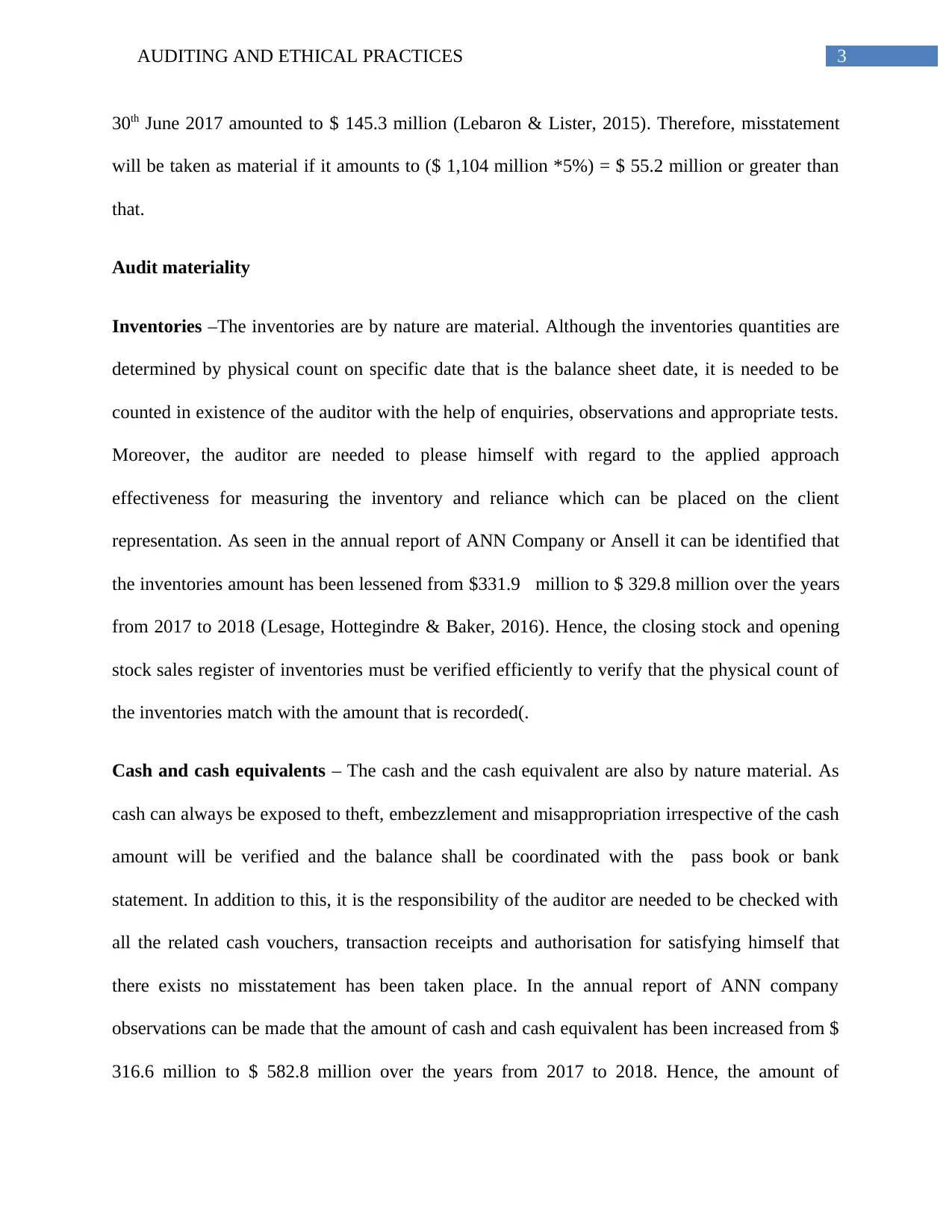
3AUDITING AND ETHICAL PRACTICES
30th June 2017 amounted to $ 145.3 million (Lebaron & Lister, 2015). Therefore, misstatement
will be taken as material if it amounts to ($ 1,104 million *5%) = $ 55.2 million or greater than
that.
Audit materiality
Inventories –The inventories are by nature are material. Although the inventories quantities are
determined by physical count on specific date that is the balance sheet date, it is needed to be
counted in existence of the auditor with the help of enquiries, observations and appropriate tests.
Moreover, the auditor are needed to please himself with regard to the applied approach
effectiveness for measuring the inventory and reliance which can be placed on the client
representation. As seen in the annual report of ANN Company or Ansell it can be identified that
the inventories amount has been lessened from $331.9 million to $ 329.8 million over the years
from 2017 to 2018 (Lesage, Hottegindre & Baker, 2016). Hence, the closing stock and opening
stock sales register of inventories must be verified efficiently to verify that the physical count of
the inventories match with the amount that is recorded(.
Cash and cash equivalents – The cash and the cash equivalent are also by nature material. As
cash can always be exposed to theft, embezzlement and misappropriation irrespective of the cash
amount will be verified and the balance shall be coordinated with the pass book or bank
statement. In addition to this, it is the responsibility of the auditor are needed to be checked with
all the related cash vouchers, transaction receipts and authorisation for satisfying himself that
there exists no misstatement has been taken place. In the annual report of ANN company
observations can be made that the amount of cash and cash equivalent has been increased from $
316.6 million to $ 582.8 million over the years from 2017 to 2018. Hence, the amount of
30th June 2017 amounted to $ 145.3 million (Lebaron & Lister, 2015). Therefore, misstatement
will be taken as material if it amounts to ($ 1,104 million *5%) = $ 55.2 million or greater than
that.
Audit materiality
Inventories –The inventories are by nature are material. Although the inventories quantities are
determined by physical count on specific date that is the balance sheet date, it is needed to be
counted in existence of the auditor with the help of enquiries, observations and appropriate tests.
Moreover, the auditor are needed to please himself with regard to the applied approach
effectiveness for measuring the inventory and reliance which can be placed on the client
representation. As seen in the annual report of ANN Company or Ansell it can be identified that
the inventories amount has been lessened from $331.9 million to $ 329.8 million over the years
from 2017 to 2018 (Lesage, Hottegindre & Baker, 2016). Hence, the closing stock and opening
stock sales register of inventories must be verified efficiently to verify that the physical count of
the inventories match with the amount that is recorded(.
Cash and cash equivalents – The cash and the cash equivalent are also by nature material. As
cash can always be exposed to theft, embezzlement and misappropriation irrespective of the cash
amount will be verified and the balance shall be coordinated with the pass book or bank
statement. In addition to this, it is the responsibility of the auditor are needed to be checked with
all the related cash vouchers, transaction receipts and authorisation for satisfying himself that
there exists no misstatement has been taken place. In the annual report of ANN company
observations can be made that the amount of cash and cash equivalent has been increased from $
316.6 million to $ 582.8 million over the years from 2017 to 2018. Hence, the amount of
Paraphrase This Document
Need a fresh take? Get an instant paraphrase of this document with our AI Paraphraser
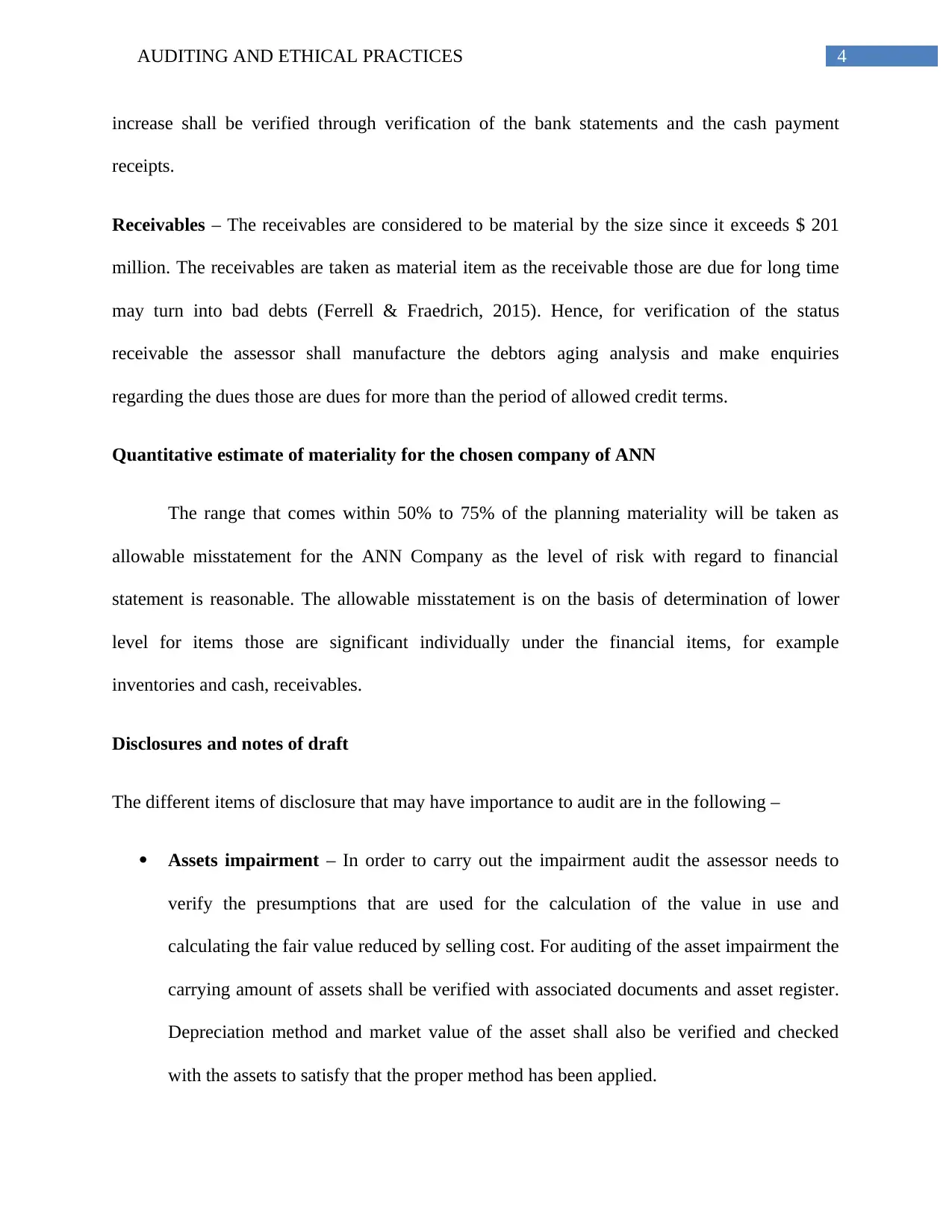
4AUDITING AND ETHICAL PRACTICES
increase shall be verified through verification of the bank statements and the cash payment
receipts.
Receivables – The receivables are considered to be material by the size since it exceeds $ 201
million. The receivables are taken as material item as the receivable those are due for long time
may turn into bad debts (Ferrell & Fraedrich, 2015). Hence, for verification of the status
receivable the assessor shall manufacture the debtors aging analysis and make enquiries
regarding the dues those are dues for more than the period of allowed credit terms.
Quantitative estimate of materiality for the chosen company of ANN
The range that comes within 50% to 75% of the planning materiality will be taken as
allowable misstatement for the ANN Company as the level of risk with regard to financial
statement is reasonable. The allowable misstatement is on the basis of determination of lower
level for items those are significant individually under the financial items, for example
inventories and cash, receivables.
Disclosures and notes of draft
The different items of disclosure that may have importance to audit are in the following –
Assets impairment – In order to carry out the impairment audit the assessor needs to
verify the presumptions that are used for the calculation of the value in use and
calculating the fair value reduced by selling cost. For auditing of the asset impairment the
carrying amount of assets shall be verified with associated documents and asset register.
Depreciation method and market value of the asset shall also be verified and checked
with the assets to satisfy that the proper method has been applied.
increase shall be verified through verification of the bank statements and the cash payment
receipts.
Receivables – The receivables are considered to be material by the size since it exceeds $ 201
million. The receivables are taken as material item as the receivable those are due for long time
may turn into bad debts (Ferrell & Fraedrich, 2015). Hence, for verification of the status
receivable the assessor shall manufacture the debtors aging analysis and make enquiries
regarding the dues those are dues for more than the period of allowed credit terms.
Quantitative estimate of materiality for the chosen company of ANN
The range that comes within 50% to 75% of the planning materiality will be taken as
allowable misstatement for the ANN Company as the level of risk with regard to financial
statement is reasonable. The allowable misstatement is on the basis of determination of lower
level for items those are significant individually under the financial items, for example
inventories and cash, receivables.
Disclosures and notes of draft
The different items of disclosure that may have importance to audit are in the following –
Assets impairment – In order to carry out the impairment audit the assessor needs to
verify the presumptions that are used for the calculation of the value in use and
calculating the fair value reduced by selling cost. For auditing of the asset impairment the
carrying amount of assets shall be verified with associated documents and asset register.
Depreciation method and market value of the asset shall also be verified and checked
with the assets to satisfy that the proper method has been applied.
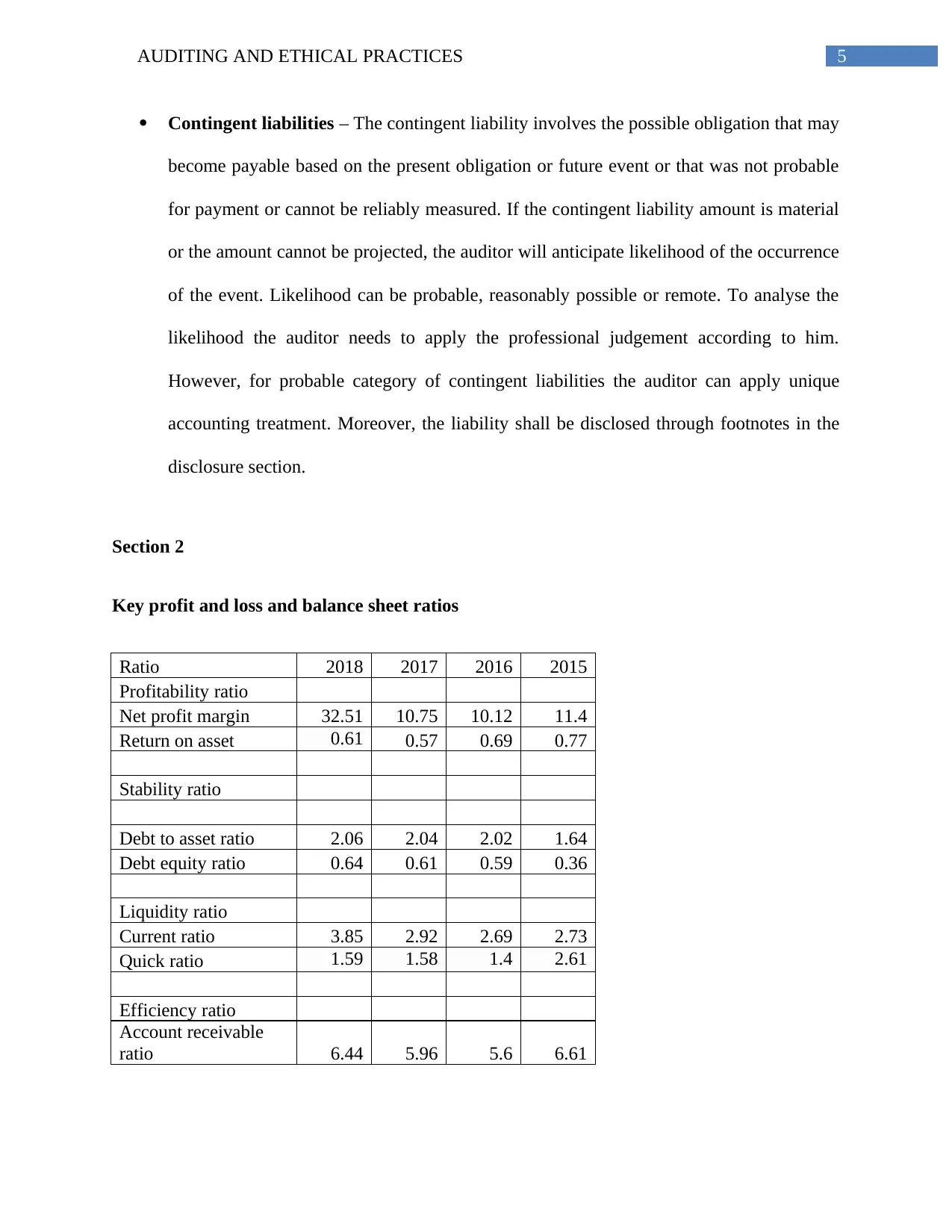
5AUDITING AND ETHICAL PRACTICES
Contingent liabilities – The contingent liability involves the possible obligation that may
become payable based on the present obligation or future event or that was not probable
for payment or cannot be reliably measured. If the contingent liability amount is material
or the amount cannot be projected, the auditor will anticipate likelihood of the occurrence
of the event. Likelihood can be probable, reasonably possible or remote. To analyse the
likelihood the auditor needs to apply the professional judgement according to him.
However, for probable category of contingent liabilities the auditor can apply unique
accounting treatment. Moreover, the liability shall be disclosed through footnotes in the
disclosure section.
Section 2
Key profit and loss and balance sheet ratios
Ratio 2018 2017 2016 2015
Profitability ratio
Net profit margin 32.51 10.75 10.12 11.4
Return on asset 0.61 0.57 0.69 0.77
Stability ratio
Debt to asset ratio 2.06 2.04 2.02 1.64
Debt equity ratio 0.64 0.61 0.59 0.36
Liquidity ratio
Current ratio 3.85 2.92 2.69 2.73
Quick ratio 1.59 1.58 1.4 2.61
Efficiency ratio
Account receivable
ratio 6.44 5.96 5.6 6.61
Contingent liabilities – The contingent liability involves the possible obligation that may
become payable based on the present obligation or future event or that was not probable
for payment or cannot be reliably measured. If the contingent liability amount is material
or the amount cannot be projected, the auditor will anticipate likelihood of the occurrence
of the event. Likelihood can be probable, reasonably possible or remote. To analyse the
likelihood the auditor needs to apply the professional judgement according to him.
However, for probable category of contingent liabilities the auditor can apply unique
accounting treatment. Moreover, the liability shall be disclosed through footnotes in the
disclosure section.
Section 2
Key profit and loss and balance sheet ratios
Ratio 2018 2017 2016 2015
Profitability ratio
Net profit margin 32.51 10.75 10.12 11.4
Return on asset 0.61 0.57 0.69 0.77
Stability ratio
Debt to asset ratio 2.06 2.04 2.02 1.64
Debt equity ratio 0.64 0.61 0.59 0.36
Liquidity ratio
Current ratio 3.85 2.92 2.69 2.73
Quick ratio 1.59 1.58 1.4 2.61
Efficiency ratio
Account receivable
ratio 6.44 5.96 5.6 6.61
⊘ This is a preview!⊘
Do you want full access?
Subscribe today to unlock all pages.

Trusted by 1+ million students worldwide
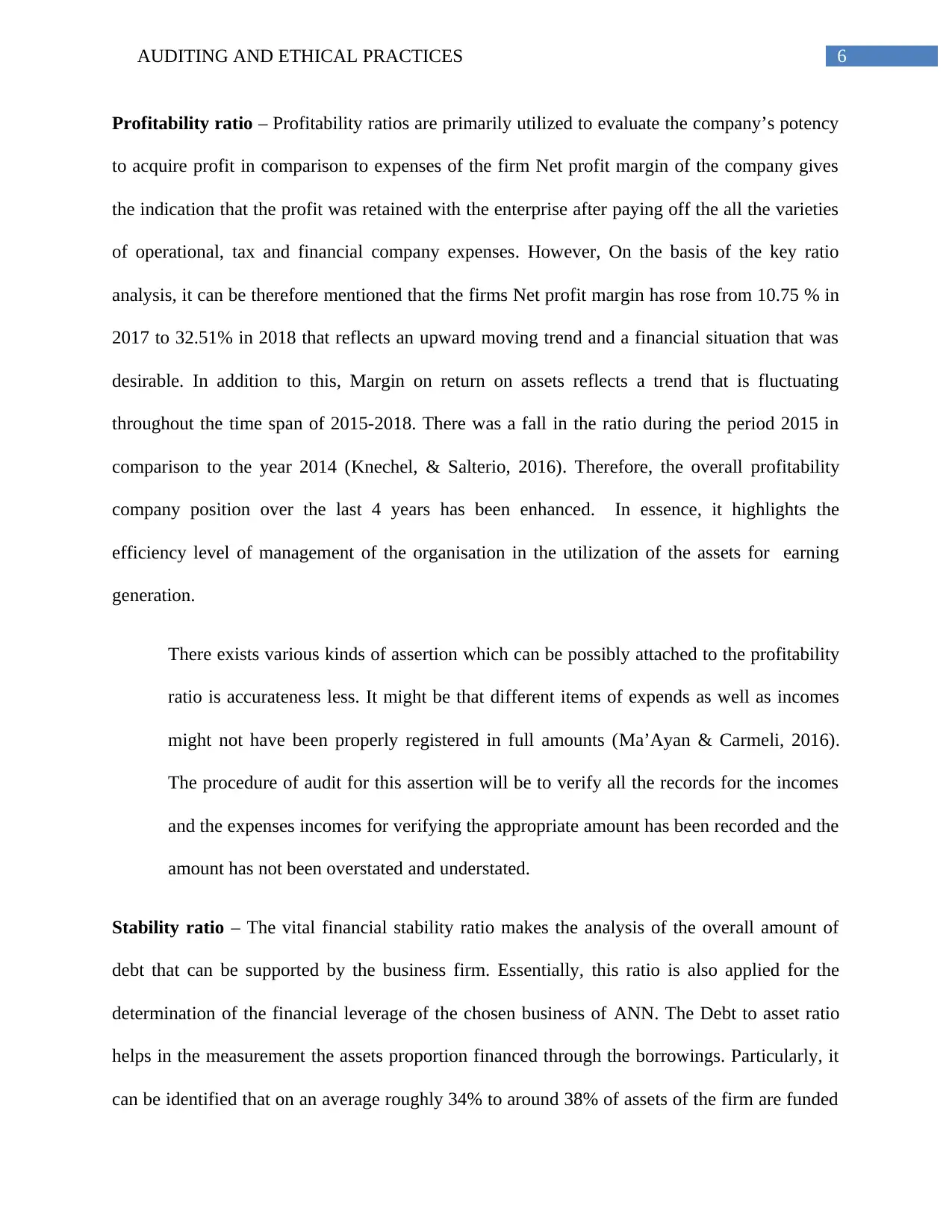
6AUDITING AND ETHICAL PRACTICES
Profitability ratio – Profitability ratios are primarily utilized to evaluate the company’s potency
to acquire profit in comparison to expenses of the firm Net profit margin of the company gives
the indication that the profit was retained with the enterprise after paying off the all the varieties
of operational, tax and financial company expenses. However, On the basis of the key ratio
analysis, it can be therefore mentioned that the firms Net profit margin has rose from 10.75 % in
2017 to 32.51% in 2018 that reflects an upward moving trend and a financial situation that was
desirable. In addition to this, Margin on return on assets reflects a trend that is fluctuating
throughout the time span of 2015-2018. There was a fall in the ratio during the period 2015 in
comparison to the year 2014 (Knechel, & Salterio, 2016). Therefore, the overall profitability
company position over the last 4 years has been enhanced. In essence, it highlights the
efficiency level of management of the organisation in the utilization of the assets for earning
generation.
There exists various kinds of assertion which can be possibly attached to the profitability
ratio is accurateness less. It might be that different items of expends as well as incomes
might not have been properly registered in full amounts (Ma’Ayan & Carmeli, 2016).
The procedure of audit for this assertion will be to verify all the records for the incomes
and the expenses incomes for verifying the appropriate amount has been recorded and the
amount has not been overstated and understated.
Stability ratio – The vital financial stability ratio makes the analysis of the overall amount of
debt that can be supported by the business firm. Essentially, this ratio is also applied for the
determination of the financial leverage of the chosen business of ANN. The Debt to asset ratio
helps in the measurement the assets proportion financed through the borrowings. Particularly, it
can be identified that on an average roughly 34% to around 38% of assets of the firm are funded
Profitability ratio – Profitability ratios are primarily utilized to evaluate the company’s potency
to acquire profit in comparison to expenses of the firm Net profit margin of the company gives
the indication that the profit was retained with the enterprise after paying off the all the varieties
of operational, tax and financial company expenses. However, On the basis of the key ratio
analysis, it can be therefore mentioned that the firms Net profit margin has rose from 10.75 % in
2017 to 32.51% in 2018 that reflects an upward moving trend and a financial situation that was
desirable. In addition to this, Margin on return on assets reflects a trend that is fluctuating
throughout the time span of 2015-2018. There was a fall in the ratio during the period 2015 in
comparison to the year 2014 (Knechel, & Salterio, 2016). Therefore, the overall profitability
company position over the last 4 years has been enhanced. In essence, it highlights the
efficiency level of management of the organisation in the utilization of the assets for earning
generation.
There exists various kinds of assertion which can be possibly attached to the profitability
ratio is accurateness less. It might be that different items of expends as well as incomes
might not have been properly registered in full amounts (Ma’Ayan & Carmeli, 2016).
The procedure of audit for this assertion will be to verify all the records for the incomes
and the expenses incomes for verifying the appropriate amount has been recorded and the
amount has not been overstated and understated.
Stability ratio – The vital financial stability ratio makes the analysis of the overall amount of
debt that can be supported by the business firm. Essentially, this ratio is also applied for the
determination of the financial leverage of the chosen business of ANN. The Debt to asset ratio
helps in the measurement the assets proportion financed through the borrowings. Particularly, it
can be identified that on an average roughly 34% to around 38% of assets of the firm are funded
Paraphrase This Document
Need a fresh take? Get an instant paraphrase of this document with our AI Paraphraser
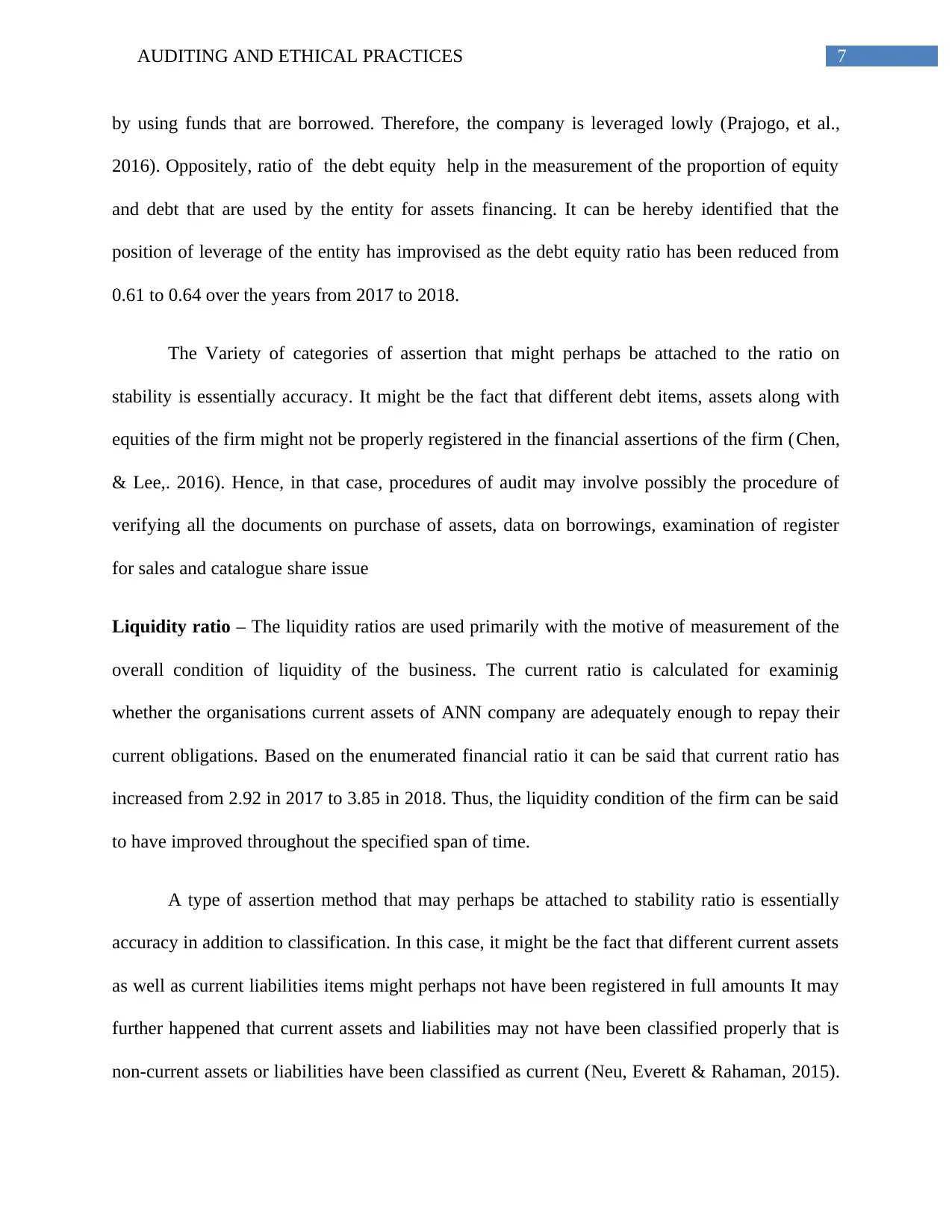
7AUDITING AND ETHICAL PRACTICES
by using funds that are borrowed. Therefore, the company is leveraged lowly (Prajogo, et al.,
2016). Oppositely, ratio of the debt equity help in the measurement of the proportion of equity
and debt that are used by the entity for assets financing. It can be hereby identified that the
position of leverage of the entity has improvised as the debt equity ratio has been reduced from
0.61 to 0.64 over the years from 2017 to 2018.
The Variety of categories of assertion that might perhaps be attached to the ratio on
stability is essentially accuracy. It might be the fact that different debt items, assets along with
equities of the firm might not be properly registered in the financial assertions of the firm (Chen,
& Lee,. 2016). Hence, in that case, procedures of audit may involve possibly the procedure of
verifying all the documents on purchase of assets, data on borrowings, examination of register
for sales and catalogue share issue
Liquidity ratio – The liquidity ratios are used primarily with the motive of measurement of the
overall condition of liquidity of the business. The current ratio is calculated for examinig
whether the organisations current assets of ANN company are adequately enough to repay their
current obligations. Based on the enumerated financial ratio it can be said that current ratio has
increased from 2.92 in 2017 to 3.85 in 2018. Thus, the liquidity condition of the firm can be said
to have improved throughout the specified span of time.
A type of assertion method that may perhaps be attached to stability ratio is essentially
accuracy in addition to classification. In this case, it might be the fact that different current assets
as well as current liabilities items might perhaps not have been registered in full amounts It may
further happened that current assets and liabilities may not have been classified properly that is
non-current assets or liabilities have been classified as current (Neu, Everett & Rahaman, 2015).
by using funds that are borrowed. Therefore, the company is leveraged lowly (Prajogo, et al.,
2016). Oppositely, ratio of the debt equity help in the measurement of the proportion of equity
and debt that are used by the entity for assets financing. It can be hereby identified that the
position of leverage of the entity has improvised as the debt equity ratio has been reduced from
0.61 to 0.64 over the years from 2017 to 2018.
The Variety of categories of assertion that might perhaps be attached to the ratio on
stability is essentially accuracy. It might be the fact that different debt items, assets along with
equities of the firm might not be properly registered in the financial assertions of the firm (Chen,
& Lee,. 2016). Hence, in that case, procedures of audit may involve possibly the procedure of
verifying all the documents on purchase of assets, data on borrowings, examination of register
for sales and catalogue share issue
Liquidity ratio – The liquidity ratios are used primarily with the motive of measurement of the
overall condition of liquidity of the business. The current ratio is calculated for examinig
whether the organisations current assets of ANN company are adequately enough to repay their
current obligations. Based on the enumerated financial ratio it can be said that current ratio has
increased from 2.92 in 2017 to 3.85 in 2018. Thus, the liquidity condition of the firm can be said
to have improved throughout the specified span of time.
A type of assertion method that may perhaps be attached to stability ratio is essentially
accuracy in addition to classification. In this case, it might be the fact that different current assets
as well as current liabilities items might perhaps not have been registered in full amounts It may
further happened that current assets and liabilities may not have been classified properly that is
non-current assets or liabilities have been classified as current (Neu, Everett & Rahaman, 2015).
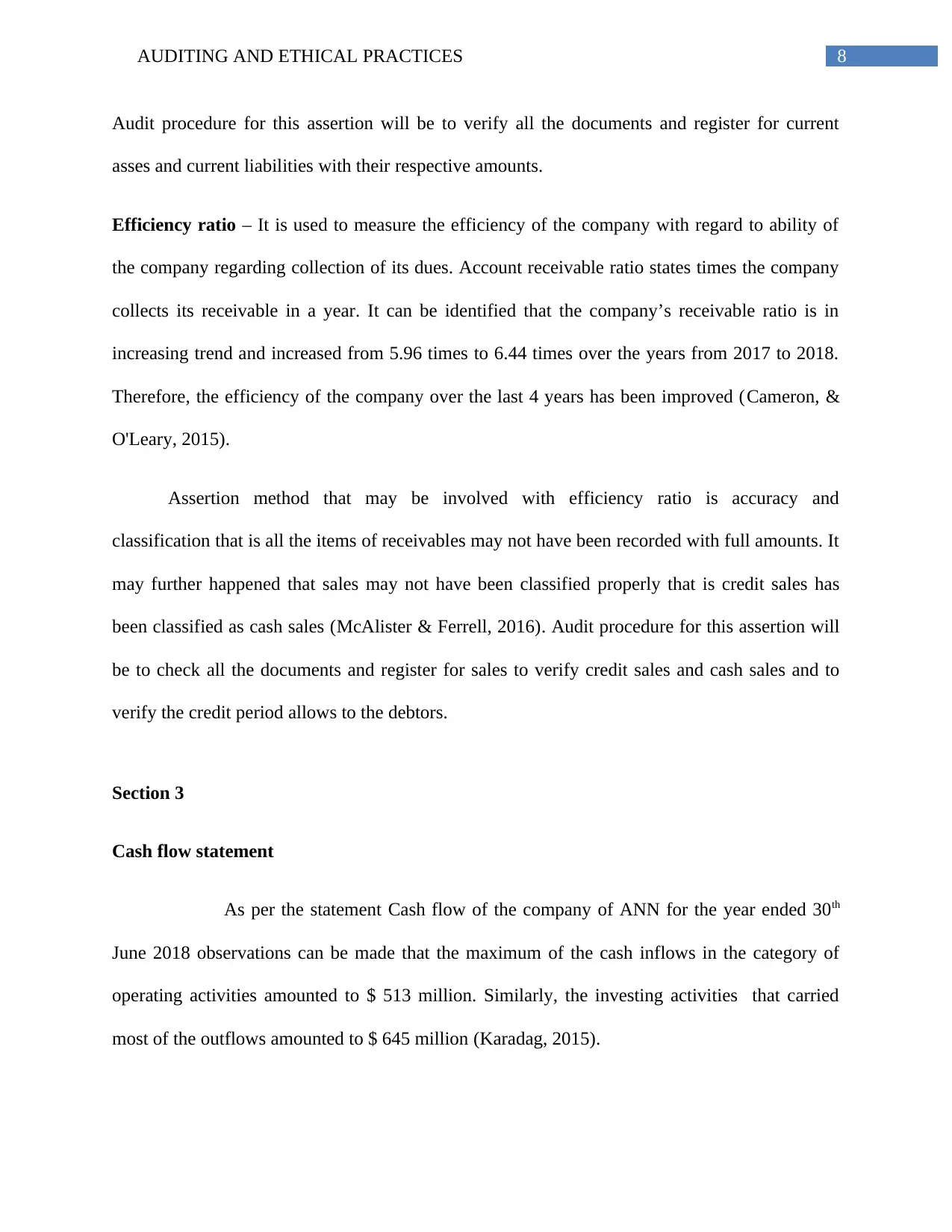
8AUDITING AND ETHICAL PRACTICES
Audit procedure for this assertion will be to verify all the documents and register for current
asses and current liabilities with their respective amounts.
Efficiency ratio – It is used to measure the efficiency of the company with regard to ability of
the company regarding collection of its dues. Account receivable ratio states times the company
collects its receivable in a year. It can be identified that the company’s receivable ratio is in
increasing trend and increased from 5.96 times to 6.44 times over the years from 2017 to 2018.
Therefore, the efficiency of the company over the last 4 years has been improved (Cameron, &
O'Leary, 2015).
Assertion method that may be involved with efficiency ratio is accuracy and
classification that is all the items of receivables may not have been recorded with full amounts. It
may further happened that sales may not have been classified properly that is credit sales has
been classified as cash sales (McAlister & Ferrell, 2016). Audit procedure for this assertion will
be to check all the documents and register for sales to verify credit sales and cash sales and to
verify the credit period allows to the debtors.
Section 3
Cash flow statement
As per the statement Cash flow of the company of ANN for the year ended 30th
June 2018 observations can be made that the maximum of the cash inflows in the category of
operating activities amounted to $ 513 million. Similarly, the investing activities that carried
most of the outflows amounted to $ 645 million (Karadag, 2015).
Audit procedure for this assertion will be to verify all the documents and register for current
asses and current liabilities with their respective amounts.
Efficiency ratio – It is used to measure the efficiency of the company with regard to ability of
the company regarding collection of its dues. Account receivable ratio states times the company
collects its receivable in a year. It can be identified that the company’s receivable ratio is in
increasing trend and increased from 5.96 times to 6.44 times over the years from 2017 to 2018.
Therefore, the efficiency of the company over the last 4 years has been improved (Cameron, &
O'Leary, 2015).
Assertion method that may be involved with efficiency ratio is accuracy and
classification that is all the items of receivables may not have been recorded with full amounts. It
may further happened that sales may not have been classified properly that is credit sales has
been classified as cash sales (McAlister & Ferrell, 2016). Audit procedure for this assertion will
be to check all the documents and register for sales to verify credit sales and cash sales and to
verify the credit period allows to the debtors.
Section 3
Cash flow statement
As per the statement Cash flow of the company of ANN for the year ended 30th
June 2018 observations can be made that the maximum of the cash inflows in the category of
operating activities amounted to $ 513 million. Similarly, the investing activities that carried
most of the outflows amounted to $ 645 million (Karadag, 2015).
⊘ This is a preview!⊘
Do you want full access?
Subscribe today to unlock all pages.

Trusted by 1+ million students worldwide
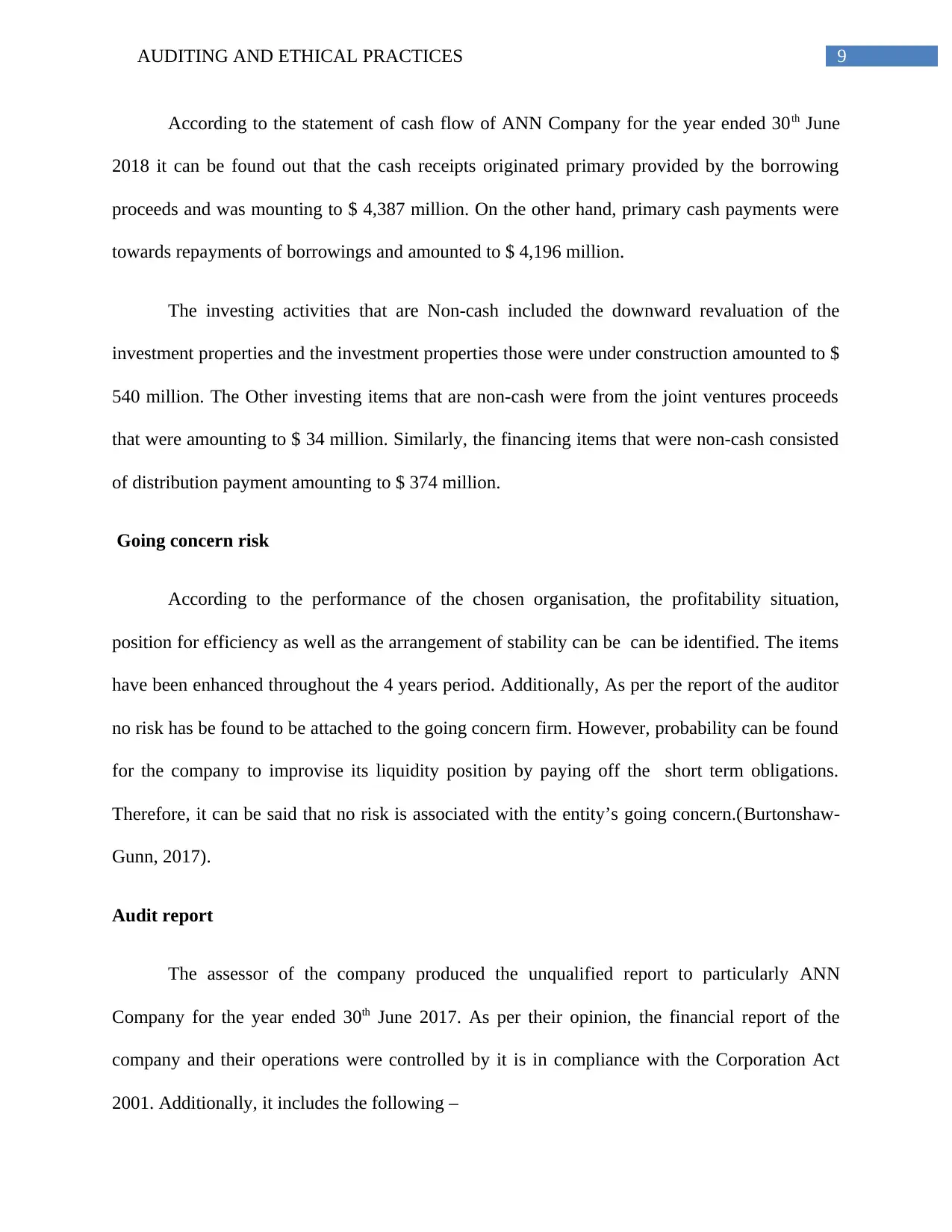
9AUDITING AND ETHICAL PRACTICES
According to the statement of cash flow of ANN Company for the year ended 30th June
2018 it can be found out that the cash receipts originated primary provided by the borrowing
proceeds and was mounting to $ 4,387 million. On the other hand, primary cash payments were
towards repayments of borrowings and amounted to $ 4,196 million.
The investing activities that are Non-cash included the downward revaluation of the
investment properties and the investment properties those were under construction amounted to $
540 million. The Other investing items that are non-cash were from the joint ventures proceeds
that were amounting to $ 34 million. Similarly, the financing items that were non-cash consisted
of distribution payment amounting to $ 374 million.
Going concern risk
According to the performance of the chosen organisation, the profitability situation,
position for efficiency as well as the arrangement of stability can be can be identified. The items
have been enhanced throughout the 4 years period. Additionally, As per the report of the auditor
no risk has be found to be attached to the going concern firm. However, probability can be found
for the company to improvise its liquidity position by paying off the short term obligations.
Therefore, it can be said that no risk is associated with the entity’s going concern.(Burtonshaw-
Gunn, 2017).
Audit report
The assessor of the company produced the unqualified report to particularly ANN
Company for the year ended 30th June 2017. As per their opinion, the financial report of the
company and their operations were controlled by it is in compliance with the Corporation Act
2001. Additionally, it includes the following –
According to the statement of cash flow of ANN Company for the year ended 30th June
2018 it can be found out that the cash receipts originated primary provided by the borrowing
proceeds and was mounting to $ 4,387 million. On the other hand, primary cash payments were
towards repayments of borrowings and amounted to $ 4,196 million.
The investing activities that are Non-cash included the downward revaluation of the
investment properties and the investment properties those were under construction amounted to $
540 million. The Other investing items that are non-cash were from the joint ventures proceeds
that were amounting to $ 34 million. Similarly, the financing items that were non-cash consisted
of distribution payment amounting to $ 374 million.
Going concern risk
According to the performance of the chosen organisation, the profitability situation,
position for efficiency as well as the arrangement of stability can be can be identified. The items
have been enhanced throughout the 4 years period. Additionally, As per the report of the auditor
no risk has be found to be attached to the going concern firm. However, probability can be found
for the company to improvise its liquidity position by paying off the short term obligations.
Therefore, it can be said that no risk is associated with the entity’s going concern.(Burtonshaw-
Gunn, 2017).
Audit report
The assessor of the company produced the unqualified report to particularly ANN
Company for the year ended 30th June 2017. As per their opinion, the financial report of the
company and their operations were controlled by it is in compliance with the Corporation Act
2001. Additionally, it includes the following –
Paraphrase This Document
Need a fresh take? Get an instant paraphrase of this document with our AI Paraphraser
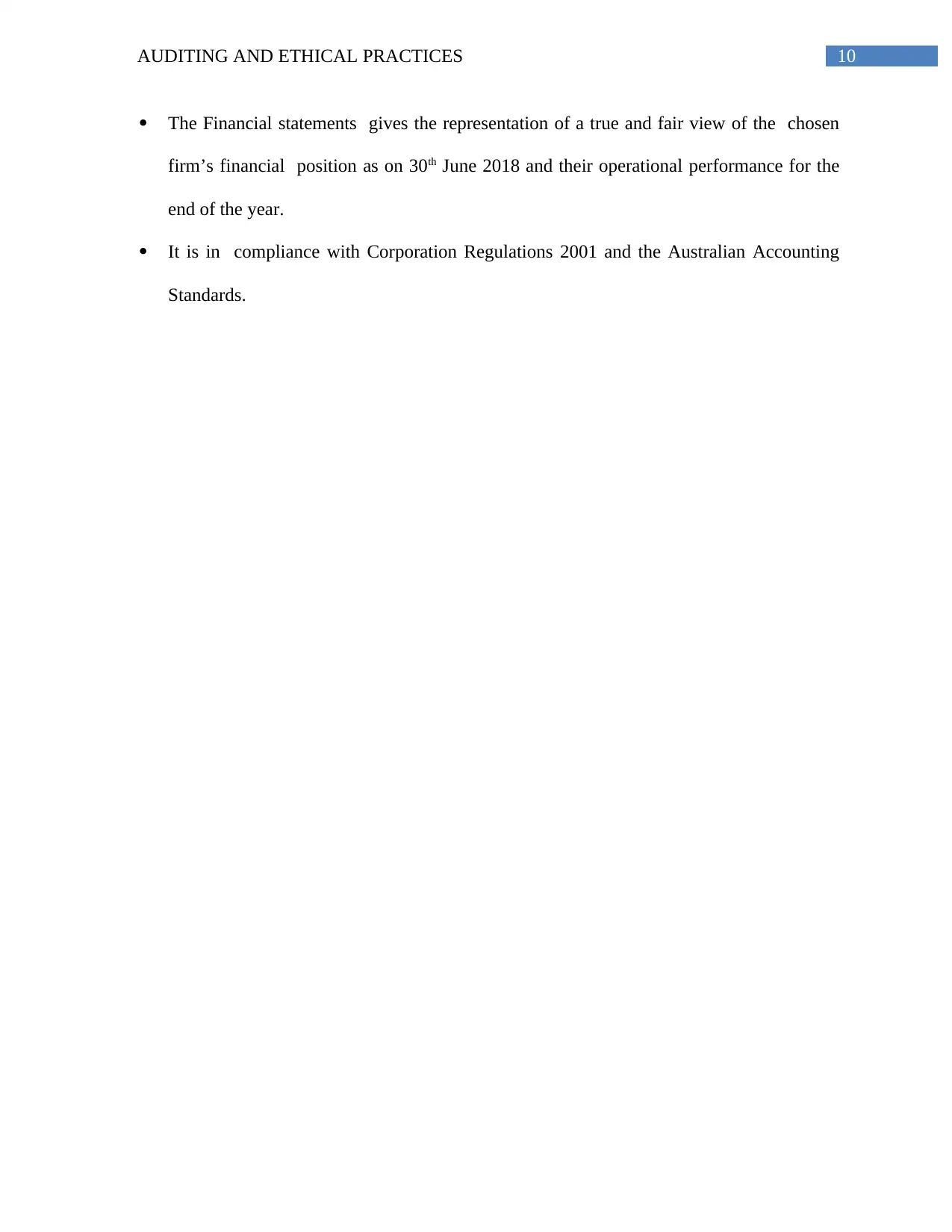
10AUDITING AND ETHICAL PRACTICES
The Financial statements gives the representation of a true and fair view of the chosen
firm’s financial position as on 30th June 2018 and their operational performance for the
end of the year.
It is in compliance with Corporation Regulations 2001 and the Australian Accounting
Standards.
The Financial statements gives the representation of a true and fair view of the chosen
firm’s financial position as on 30th June 2018 and their operational performance for the
end of the year.
It is in compliance with Corporation Regulations 2001 and the Australian Accounting
Standards.

11AUDITING AND ETHICAL PRACTICES
References
Burtonshaw-Gunn, S. A. (2017). Risk and financial management in construction. Routledge.
Cameron, R. A., & O'Leary, C. (2015). Improving ethical attitudes or simply teaching ethical
codes? The reality of accounting ethics education. Accounting Education, 24(4), 275-290.
Chen, L., & Lee, H. L. (2016). Sourcing under supplier responsibility risk: The effects of
certification, audit, and contingency payment. Management Science, 63(9), 2795-2812.
Ferrell, O. C., & Fraedrich, J. (2015). Business ethics: Ethical decision making & cases. Nelson
Education.
Guerci, M., Radaelli, G., Siletti, E., Cirella, S., & Shani, A. R. (2015). The impact of human
resource management practices and corporate sustainability on organizational ethical
climates: An employee perspective. Journal of Business Ethics, 126(2), 325-342.
Karadag, H. (2015). Financial management challenges in small and medium-sized enterprises: A
strategic management approach. EMAJ: Emerging Markets Journal, 5(1), 26-40.
Knechel, W. R., & Salterio, S. E. (2016). Auditing: Assurance and risk. Routledge.
Lebaron, G., & Lister, J. (2015). Benchmarking global supply chains: the power of the ‘ethical
audit’regime. Review of International Studies, 41(5), 905-924.
Lesage, C., Hottegindre, G., & Baker, C. R. (2016). Disciplinary practices in the French auditing
profession: Serving the public interest or the private interests of the
profession?. Accounting, Auditing & Accountability Journal, 29(1), 11-42.
References
Burtonshaw-Gunn, S. A. (2017). Risk and financial management in construction. Routledge.
Cameron, R. A., & O'Leary, C. (2015). Improving ethical attitudes or simply teaching ethical
codes? The reality of accounting ethics education. Accounting Education, 24(4), 275-290.
Chen, L., & Lee, H. L. (2016). Sourcing under supplier responsibility risk: The effects of
certification, audit, and contingency payment. Management Science, 63(9), 2795-2812.
Ferrell, O. C., & Fraedrich, J. (2015). Business ethics: Ethical decision making & cases. Nelson
Education.
Guerci, M., Radaelli, G., Siletti, E., Cirella, S., & Shani, A. R. (2015). The impact of human
resource management practices and corporate sustainability on organizational ethical
climates: An employee perspective. Journal of Business Ethics, 126(2), 325-342.
Karadag, H. (2015). Financial management challenges in small and medium-sized enterprises: A
strategic management approach. EMAJ: Emerging Markets Journal, 5(1), 26-40.
Knechel, W. R., & Salterio, S. E. (2016). Auditing: Assurance and risk. Routledge.
Lebaron, G., & Lister, J. (2015). Benchmarking global supply chains: the power of the ‘ethical
audit’regime. Review of International Studies, 41(5), 905-924.
Lesage, C., Hottegindre, G., & Baker, C. R. (2016). Disciplinary practices in the French auditing
profession: Serving the public interest or the private interests of the
profession?. Accounting, Auditing & Accountability Journal, 29(1), 11-42.
⊘ This is a preview!⊘
Do you want full access?
Subscribe today to unlock all pages.

Trusted by 1+ million students worldwide

12AUDITING AND ETHICAL PRACTICES
Ma’Ayan, Y., & Carmeli, A. (2016). Internal audits as a source of ethical behavior, efficiency,
and effectiveness in work units. Journal of business ethics, 137(2), 347-363.
McAlister, D. T., & Ferrell, O. C. (2016). Corporate governance and ethical leadership.
In Business ethics: New challenges for business schools and corporate leaders (pp. 68-
93). Routledge.
Neu, D., Everett, J., & Rahaman, A. S. (2015). Preventing corruption within government
procurement: Constructing the disciplined and ethical subject. Critical Perspectives on
Accounting, 28, 49-61.
Prajogo, D., Castka, P., Yiu, D., Yeung, A. C., & Lai, K. H. (2016). Environmental audits and
third party certification of management practices: firms’ motives, audit orientations, and
satisfaction with certification. International Journal of Auditing, 20(2), 202-210.
Sikka, P. (2015, March). The corrosive effects of neoliberalism on the UK financial crises and
auditing practices: A dead-end for reforms. In Accounting forum (Vol. 39, No. 1, pp. 1-
18). Elsevier.
Ma’Ayan, Y., & Carmeli, A. (2016). Internal audits as a source of ethical behavior, efficiency,
and effectiveness in work units. Journal of business ethics, 137(2), 347-363.
McAlister, D. T., & Ferrell, O. C. (2016). Corporate governance and ethical leadership.
In Business ethics: New challenges for business schools and corporate leaders (pp. 68-
93). Routledge.
Neu, D., Everett, J., & Rahaman, A. S. (2015). Preventing corruption within government
procurement: Constructing the disciplined and ethical subject. Critical Perspectives on
Accounting, 28, 49-61.
Prajogo, D., Castka, P., Yiu, D., Yeung, A. C., & Lai, K. H. (2016). Environmental audits and
third party certification of management practices: firms’ motives, audit orientations, and
satisfaction with certification. International Journal of Auditing, 20(2), 202-210.
Sikka, P. (2015, March). The corrosive effects of neoliberalism on the UK financial crises and
auditing practices: A dead-end for reforms. In Accounting forum (Vol. 39, No. 1, pp. 1-
18). Elsevier.
Paraphrase This Document
Need a fresh take? Get an instant paraphrase of this document with our AI Paraphraser
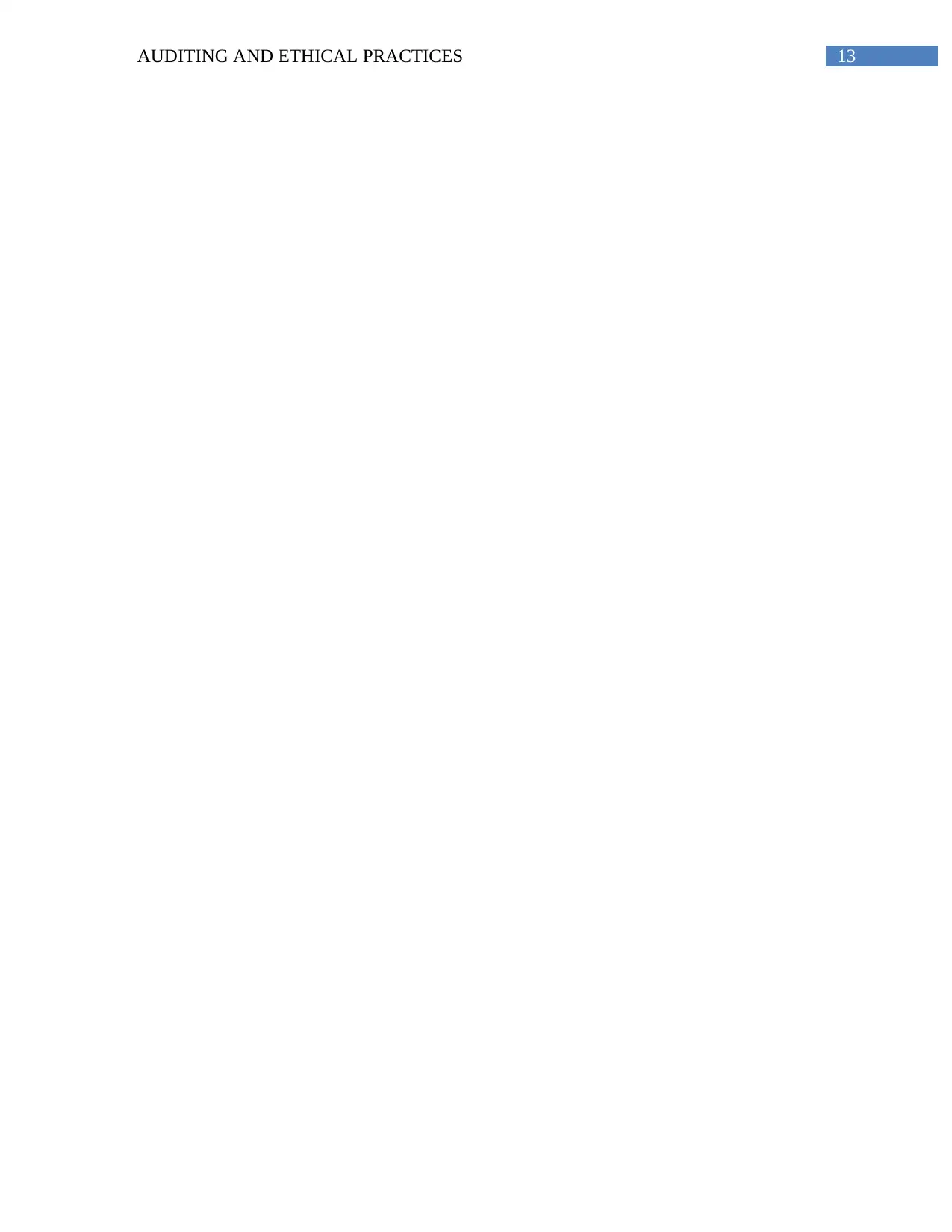
13AUDITING AND ETHICAL PRACTICES
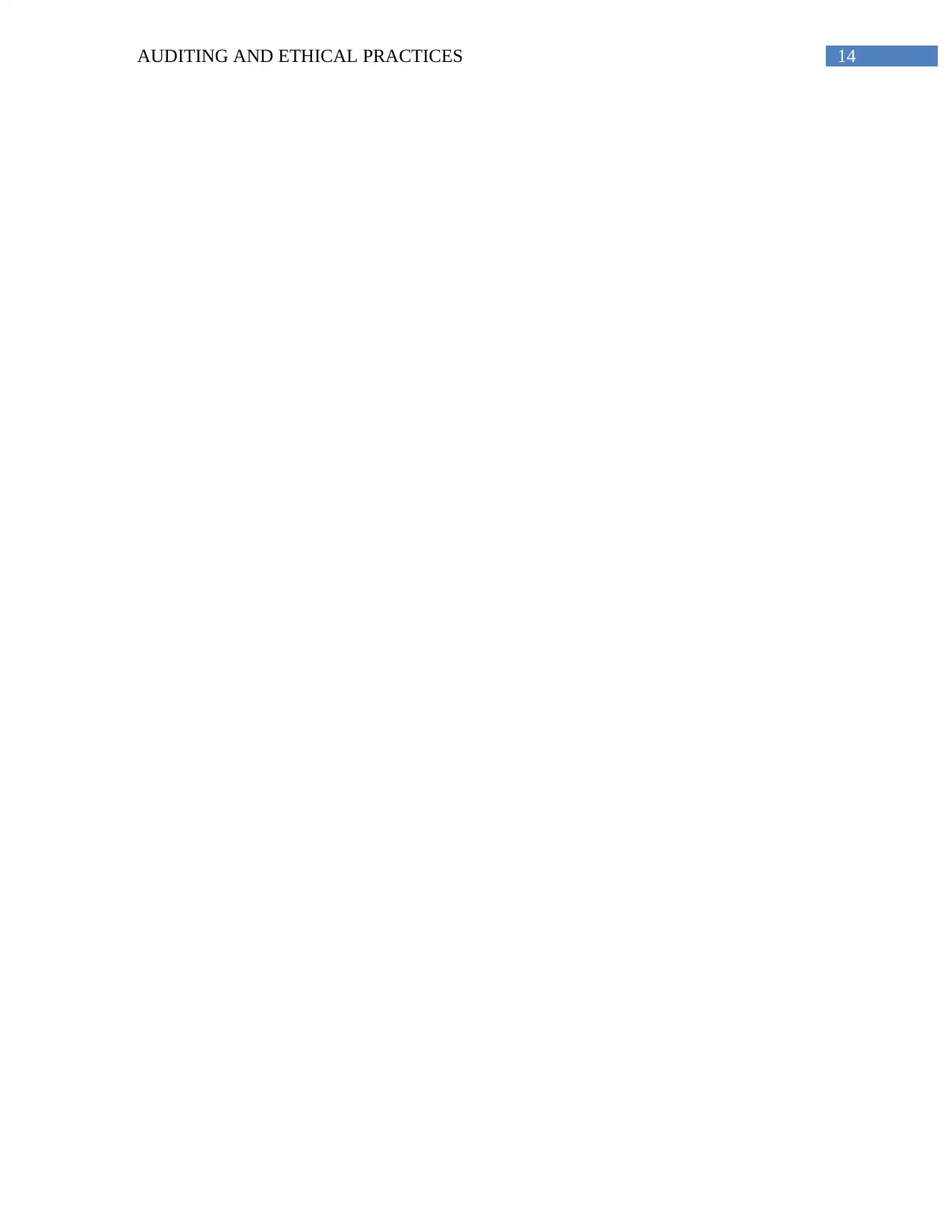
14AUDITING AND ETHICAL PRACTICES
⊘ This is a preview!⊘
Do you want full access?
Subscribe today to unlock all pages.

Trusted by 1+ million students worldwide
1 out of 15
Related Documents
Your All-in-One AI-Powered Toolkit for Academic Success.
+13062052269
info@desklib.com
Available 24*7 on WhatsApp / Email
![[object Object]](/_next/static/media/star-bottom.7253800d.svg)
Unlock your academic potential
© 2024 | Zucol Services PVT LTD | All rights reserved.





